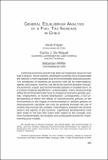Artículo
General equilibrium analysis of a fuel tax increase in Chile
Fecha
2005Resumen
Achieving economic growth has been an important issue for over half a century. More recently, developed countries have incorporated the need for a more equitable and environmentally balanced growth. The complexity of modeling an economy with all its interrelations, agents, and sectors, however, has led to the common practice of studying economic, social, and environmental policies in isolated form, in a context of partial equilibrium. Unfortunately, many measures that affect the environment also have an impact on economic growth, poverty, employment, or income distribution. Consequently, a full understanding of either the effects of macroeconomic policies on the environment or the impact of environmental or welfare policies on macroeconomic variables can only be achieved through the use of models that include the complex interrelations between the diverse sectors and agents of the economy. Significant developments have been made in the last fifty years with regard to the concepts and, more fundamentally, the analytic and computational tools for implementing such models.
Colecciones
Descargar


